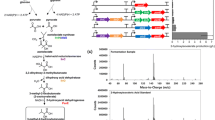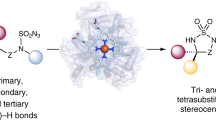Abstract.
Cis-aminoindanol, a key chiral precursor to the HIV protease inhibitor CRIXIVAN, can be derived from indene oxidation products of (2R) stereochemistry. A number of different microorganisms, notably strains of the genera Pseudomonas and Rhodococcus, have been isolated that catalyze the oxygenation of indene to indandiol with greater stereospecificity than is achievable through traditional chemical synthesis. The yield and ultimate optical purity of indandiol produced in such biocatalytic processes is influenced by the intrinsic stereospecificity of the oxygenase(s), enantioselective dehydrogenation, and the loss of substrate to alternate, undesirable metabolites. Metabolic engineering of any indene bioconversion system for the commercial-scale production of cis-aminoindanol must account for these influences, as well as pathway fluxes and enzyme regulation, to optimize the formation of oxygenated precursors with useful stereochemistry. As such, the process by which bacterial systems carry out the bioconversion of indene to indandiol serves as a model for biological production of industrially relevant chiral synthons.
Similar content being viewed by others
Author information
Authors and Affiliations
Additional information
Electronic Publication
Rights and permissions
About this article
Cite this article
O'Brien, .X., Parker, .J., Lessard, .P. et al. Engineering an indene bioconversion process for the production of cis-aminoindanol: a model system for the production of chiral synthons. Appl Microbiol Biotechnol 59, 389–399 (2002). https://doi.org/10.1007/s00253-002-1052-2
Received:
Revised:
Accepted:
Issue Date:
DOI: https://doi.org/10.1007/s00253-002-1052-2




